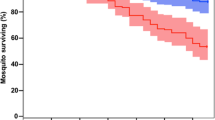Summary
The registration of the rate of mortality of Culex pipiens after feeding them with the blood of healthy and with Plasmodium cathemerium infected canary birds showed that the death rate of infected mosquitoes was higher under specific conditions. The period when the ookinetes entered the midgut epithelium appears to be decisive. Histological studies showed that the destruction of the midgut epithelium is likely to responsible for the death. A correlation appears between the number of mosquitoes which have sucked the infected blood and their mortality. When a small number of mosquitoes suck on infected birds, their life expectancy is shortened compared to those which suck in larger number. It can be explained, if we assume that in the first case the smaller number of mosquitoes take up a larger amount of infected blood and thereby a larger dosis of infection. An opposite correlation appears if the mosquitoes are allowed to suck healthy birds. — In the discussion we have also refered to the importance the damage on the mosquitoes has for the following generation and thereby for the evolution of resistant strains.
Zusammenfassung
Ein Vergleich der Mortalität von Culex pipiens nach Fütterung an gesunden und mit P. cathemerium infizierten Kanarienvögeln ergab, daß unter bestimmten Bedingungen die Sterberate bei den infizierten Mücken höher lag. Als entscheidender Termin erwies sich der Zeitpunkt des Durchtritts der Ookineten durch das Darmepithel um den 2. und 3. Tag. Nach den vorliegenden lichtoptischen Befunden dürfte die Zerstörung des Mitteldarmepithels für den Tod verantwortlich sein. Eine positive Korrelation konnte nachgewiesen werden zwischen der Anzahl Moskitos, die bei der geschilderten Versuchsanordnung gesogen hatten, und deren Lebenserwartung. Saugt eine kleine Anzahl von Mücken an infizierten Vögeln, so ist ihre Lebenserwartung verkürzt gegenüber denen, die in größerer Zahl gesogen haben. Saugen die Mücken an gesunden Vögeln, so ergibt sich ebenfalls eine Korrelation zwischen der Zahl der Mücken und der Überlebensrate jedoch mit negativem Regressionskoeffizienten. — In der Diskussion wird auf die Bedeutung hingewiesen, die die Schädigung der Moskitos für die Folgegeneration und damit auch für die Evolution übertragungsfähiger Stämme haben kann.
Similar content being viewed by others
Abbreviations
- BM:
-
Basalmembran
- Bk:
-
Blutkuchen
- C:
-
Cuticula
- EZ:
-
Epithelzelle
- Fk:
-
Fettkörper
- Mv:
-
Microvilli
- nEZ:
-
nekrotische Epithelzelle
- Ok:
-
Ookinet
- PS:
-
Peritrophische Schicht
Literatur
Bafort, J. M.: The biology of rodent malaria with particular reference to Plasmodium vinckei vinckei Rodhain 1952. Ann. Soc. belge Méd. trop. 51, 1–204 (1971).
Bishop, A.: Problems concerned with gametogenesis in haemosporidiidea, with particular reference to the genus Plasmodium. Parasitology 45, 163–185 (1955).
Corradetti, A.: Modello sperimentale, realizzato con Plasmodium gallinaceum e Anopheles stephensi, per selezionare popolazioni di plasmodio adatte a vivere in un vettore apparentemente refrattario, e per selezionare popolazioni di vettore suscettibili a un plasmodio apparentemente inadatto a vivere in esso. Parassitologia 12, 81–99 (1970).
Dennhöfer, U.: Erblichkeit der Übertragungsfähigkeit bzw. Resistenz gegen Vogelmalaria bei der Stechmücke Culex pipiens L. Anz. Schädlingsk. und Pflanzenschutz 44, 84–91 (1971).
Eyles, D. E.: Studies on Plasmodium gallinaceum. I. Characteristics of the Infection in the mosquito Aedes aegypti. Amer. J. Hyg. 54, 101–112 (1951).
Eyles, D. E.: Studies on Plasmodium gallinaceum. II. Factors in the blood of the vertebrate host influencing mosquito infection. Amer. J. Hyg. 55, 276–290 (1952).
Eyles, D. E.: Studies on Plasmodium gallinaceum. III. Factors associated with the malaria infection in the vertebrate host which influence the degree of infection in the mosquito. Amer. J. Hyg. 55, 386–391 (1952b).
Gander, E.: Zur Histochemie und Histologie des Mitteldarmes von Aedes aegypti und Anopheles stephensi in Zusammenhang mit der Blutverdauung. Acta trop. (Basel) 25, 133–175 (1968).
Garnham, P. C.: „Malaria parasites and other haemosporidia“. Oxford: Blackwell Scientific Publications 1966.
Garnham, P. C., Bird, R. G., Baker, J. R.: Electron microscopic studies of motile stages of malaria parasites. III. The ookinetes of haemamoeba and plasmodium. Trans. roy. Soc. trop. Med. Hyg. 56, 116–120 (1962).
Garnham, P. C., Bird, R. G., Baker, J. R., Desser, S. S., E-Nahal, H. M.: Electron microscope studies on motile stages of malaria parasites. VI. The ookinete of Plasmodium berghei yoelii and its transformation into early oocyst. Trans. roy. Soc. trop. Med. Hyg. 63, 187–194 (1969).
Hawking, F., Mellanby, H., Terry, R. J., Webber, W. A. F.: Transmission of Plasmodium knowlesi by Anopheles stephensi. Trans. roy. Soc. trop. Med. Hyg. 51, 397–402 (1957).
Huff, C. G.: Studies on the infectivity of Plasmodia of birds for mosquitoes, with special reference to the problem of immunity in the mosquito. Amer. J. Hyg. 7, 706–734 (1927).
Huff, C. G.: The inheritance of natural immunity to Plasmodium cathemerium in two species of Culex. J. prev. Med. 5, 249–259 (1931).
Huff, C. G., Marchbank, D. F.: Changes in infectiousness of malarial gametocytes. I. Pattern of oocyst production in seven host-parasite combinations. Exp. Parasit. 4, 256–270 (1955).
Huff, C. G., Marchbank, D. F., Shirishi, T.: Changes in infectiousness of malarial gametocytes. II. Analysis of the possible causative factors. Exp. Parasit. 7, 399–417 (1958).
Mayr, E.: Artbegriff und Evolution. Hamburg und Berlin: Parey 1967.
Omar, M. S.: Die Empfänglichkeit verschiedener Anopheles-Arten für den Erreger der Affenmalaria Plasmodium cynomolgi bastianelli. Z. Tropenmed. Parasit. 19, 152–170 (1968).
Oelerich, S.: Vergleichende Untersuchungen über das Auftreten von Malaria-Sporozoiten in den Speicheldrüsen und in den übrigen Organen der Mücke. Z. Tropenmed. Parasit. 18, 285–303 (1967).
Shah, K. S., Rozeboom, L. E., Rosario, F.: Studies on the infectivity of Plasmodium cathemerium of canaries for mosquitoes. Amer. J. Hyg. 20, 502–507 (1967).
Stohler, H.: Analyse des Infektionsverlaufes von Plasmodium gallinaceum im Darme von Aedes aegypti. Acta trop. (Basel) 14, 301–352 (1957).
Author information
Authors and Affiliations
Additional information
Wir danken Herrn Prof. Dr. Dr. W. Schulemann für viele Anregungen und Gespräche, durch die die Arbeit gefördert wurde.
Rights and permissions
About this article
Cite this article
Maier, W.A. Über die Mortalität von Culex pipiens fatigans nach Infektion mit Plasmodium cathemerium . Z. Parasitenk. 41, 11–28 (1973). https://doi.org/10.1007/BF00329627
Received:
Issue Date:
DOI: https://doi.org/10.1007/BF00329627




